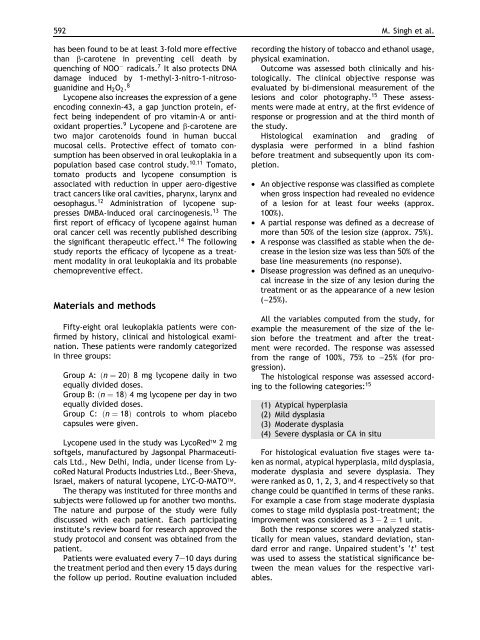Efficacy of oral lycopene in the treatment of oral ... - ResearchGate
Efficacy of oral lycopene in the treatment of oral ... - ResearchGate
Efficacy of oral lycopene in the treatment of oral ... - ResearchGate
You also want an ePaper? Increase the reach of your titles
YUMPU automatically turns print PDFs into web optimized ePapers that Google loves.
592 M. S<strong>in</strong>gh et al.has been found to be at least 3-fold more effectivethan b-carotene <strong>in</strong> prevent<strong>in</strong>g cell death byquench<strong>in</strong>g <strong>of</strong> NOO radicals. 7 It also protects DNAdamage <strong>in</strong>duced by 1-methyl-3-nitro-1-nitrosoguanid<strong>in</strong>eand H 2 O 2 . 8Lycopene also <strong>in</strong>creases <strong>the</strong> expression <strong>of</strong> a geneencod<strong>in</strong>g connex<strong>in</strong>-43, a gap junction prote<strong>in</strong>, effectbe<strong>in</strong>g <strong>in</strong>dependent <strong>of</strong> pro vitam<strong>in</strong>-A or antioxidantproperties. 9 Lycopene and b-carotene aretwo major carotenoids found <strong>in</strong> human buccalmucosal cells. Protective effect <strong>of</strong> tomato consumptionhas been observed <strong>in</strong> <strong>oral</strong> leukoplakia <strong>in</strong> apopulation based case control study. 10;11 Tomato,tomato products and <strong>lycopene</strong> consumption isassociated with reduction <strong>in</strong> upper aero-digestivetract cancers like <strong>oral</strong> cavities, pharynx, larynx andoesophagus. 12 Adm<strong>in</strong>istration <strong>of</strong> <strong>lycopene</strong> suppressesDMBA-<strong>in</strong>duced <strong>oral</strong> carc<strong>in</strong>ogenesis. 13 Thefirst report <strong>of</strong> efficacy <strong>of</strong> <strong>lycopene</strong> aga<strong>in</strong>st human<strong>oral</strong> cancer cell was recently published describ<strong>in</strong>g<strong>the</strong> significant <strong>the</strong>rapeutic effect. 14 The follow<strong>in</strong>gstudy reports <strong>the</strong> efficacy <strong>of</strong> <strong>lycopene</strong> as a <strong>treatment</strong>modality <strong>in</strong> <strong>oral</strong> leukoplakia and its probablechemopreventive effect.Materials and methodsFifty-eight <strong>oral</strong> leukoplakia patients were confirmedby history, cl<strong>in</strong>ical and histological exam<strong>in</strong>ation.These patients were randomly categorized<strong>in</strong> three groups:Group A: ðn ¼ 20Þ 8 mg <strong>lycopene</strong> daily <strong>in</strong> twoequally divided doses.Group B: ðn ¼ 18Þ 4 mg <strong>lycopene</strong> per day <strong>in</strong> twoequally divided doses.Group C: ðn ¼ 18Þ controls to whom placebocapsules were given.Lycopene used <strong>in</strong> <strong>the</strong> study was LycoRedä 2mgs<strong>of</strong>tgels, manufactured by Jagsonpal PharmaceuticalsLtd., New Delhi, India, under license from LycoRedNatural Products Industries Ltd., Beer-Sheva,Israel, makers <strong>of</strong> natural <strong>lycopene</strong>, LYC-O-MATOä.The <strong>the</strong>rapy was <strong>in</strong>stituted for three months andsubjects were followed up for ano<strong>the</strong>r two months.The nature and purpose <strong>of</strong> <strong>the</strong> study were fullydiscussed with each patient. Each participat<strong>in</strong>g<strong>in</strong>stitute’s review board for research approved <strong>the</strong>study protocol and consent was obta<strong>in</strong>ed from <strong>the</strong>patient.Patients were evaluated every 7–10 days dur<strong>in</strong>g<strong>the</strong> <strong>treatment</strong> period and <strong>the</strong>n every 15 days dur<strong>in</strong>g<strong>the</strong> follow up period. Rout<strong>in</strong>e evaluation <strong>in</strong>cludedrecord<strong>in</strong>g <strong>the</strong> history <strong>of</strong> tobacco and ethanol usage,physical exam<strong>in</strong>ation.Outcome was assessed both cl<strong>in</strong>ically and histologically.The cl<strong>in</strong>ical objective response wasevaluated by bi-dimensional measurement <strong>of</strong> <strong>the</strong>lesions and color photography. 15 These assessmentswere made at entry, at <strong>the</strong> first evidence <strong>of</strong>response or progression and at <strong>the</strong> third month <strong>of</strong><strong>the</strong> study.Histological exam<strong>in</strong>ation and grad<strong>in</strong>g <strong>of</strong>dysplasia were performed <strong>in</strong> a bl<strong>in</strong>d fashionbefore <strong>treatment</strong> and subsequently upon its completion.• An objective response was classified as completewhen gross <strong>in</strong>spection had revealed no evidence<strong>of</strong> a lesion for at least four weeks (approx.100%).• A partial response was def<strong>in</strong>ed as a decrease <strong>of</strong>more than 50% <strong>of</strong> <strong>the</strong> lesion size (approx. 75%).• A response was classified as stable when <strong>the</strong> decrease<strong>in</strong> <strong>the</strong> lesion size was less than 50% <strong>of</strong> <strong>the</strong>base l<strong>in</strong>e measurements (no response).• Disease progression was def<strong>in</strong>ed as an unequivocal<strong>in</strong>crease <strong>in</strong> <strong>the</strong> size <strong>of</strong> any lesion dur<strong>in</strong>g <strong>the</strong><strong>treatment</strong> or as <strong>the</strong> appearance <strong>of</strong> a new lesion()25%).All <strong>the</strong> variables computed from <strong>the</strong> study, forexample <strong>the</strong> measurement <strong>of</strong> <strong>the</strong> size <strong>of</strong> <strong>the</strong> lesionbefore <strong>the</strong> <strong>treatment</strong> and after <strong>the</strong> <strong>treatment</strong>were recorded. The response was assessedfrom <strong>the</strong> range <strong>of</strong> 100%, 75% to )25% (for progression).The histological response was assessed accord<strong>in</strong>gto <strong>the</strong> follow<strong>in</strong>g categories: 15(1) Atypical hyperplasia(2) Mild dysplasia(3) Moderate dysplasia(4) Severe dysplasia or CA <strong>in</strong> situFor histological evaluation five stages were takenas normal, atypical hyperplasia, mild dysplasia,moderate dysplasia and severe dysplasia. Theywere ranked as 0, 1, 2, 3, and 4 respectively so thatchange could be quantified <strong>in</strong> terms <strong>of</strong> <strong>the</strong>se ranks.For example a case from stage moderate dysplasiacomes to stage mild dysplasia post-<strong>treatment</strong>; <strong>the</strong>improvement was considered as 3 2 ¼ 1 unit.Both <strong>the</strong> response scores were analyzed statisticallyfor mean values, standard deviation, standarderror and range. Unpaired student’s ‘t’ testwas used to assess <strong>the</strong> statistical significance between<strong>the</strong> mean values for <strong>the</strong> respective variables.


